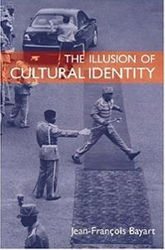“Historical experience shows that an individual’s act of identification is always contextual, multiple, and relative. For example, someone from Saint-Malo will define himself as a resident of that town when dealing with someone from Rennes, as a Breton when dealing with someone from Paris, as French when dealing with some from Germany, as a Continue reading “Bayart on Contextual Identification”
Bayart on Processes

“Whereas culturalist reasoning posits the existence of a permanent inner core peculiar to each culture that confers on the latter its veridical nature and determines the present, analysis reveals a process of cultural elaboration in the areas of ideology and sensibility that speaks to us of the present by fabricating the past…. For the culturalist believes Continue reading “Bayart on Processes”
Bayart on Authenticity
“This discourse on an entirely reconstituted, fantasized past is first of all a critical commentary on the present. In other words, it is bitterly disputed. Thus the restoration of works of art elicits virulent public debate, such as that which accompanied the restoration of the Sistine Chapel. The Continue reading “Bayart on Authenticity”
Bayart on the Ironies of Colonialism
“Faced with Franciscans who deployed an evangelism of a culturalist type and sought to legitimise authochthonous civilisation to the point of taking care to respect its established hierarchy, the sedentary natives of New Spain chose to submit and to accept the Europeans’ religion. However, they converted ‘in order to remain Indians’. The Continue reading “Bayart on the Ironies of Colonialism”
Bayart on Fabricating the Popular
“Popular cultures themselves — whose definition by intellectuals was, as we have seen, a highpoint of the movement of identity-related closure — have never been as homogenous as they were supposed to be by the theoreticians of the invention of tradition, and in particular by the nationalists of Central and Eastern Europe. Continue reading “Bayart on Fabricating the Popular”
Bayart on Strategic Syncretism
“While British colonial administrators fabricated ‘Indianness’, Hindu intellectuals were formulating Hinduness by resorting to ‘strategic syncretism’. According to Christophe Jaffrelot, this involved ‘structuring one’s identity in opposition to the Other by assimilating the latter’s prestigious and efficacious cultural characteristics’: ‘The appearance of an exogenous threat awakened in the Hindu majority a feeling of vulnerability, and even an inferiority complex, that justified a reform of Hinduism borrowing from the aggressor its strong points, under the cover of a return to the sources of a prestigious Vedic Golden Age that was largely reinvented but whose “xenology” remained active’.*… In short, the reinterpretation of India’s ‘Hindu’ past by the nationalists and their instrumentalisation of ‘tradition’ for militant political purposes have for nearly a century sustained a political identity unprecedented in the cultural landscape of the sub-continent, by incorporating foreign representations into Hinduism — e.g., egalitarian individualism, proselytisation, ecclesiastical structures — and by seeking to ‘homogenise in order to create a nation, a society that is characterised by extreme differentiation’.** On the Indian political chessboard, the celebration of a golden Vedic age is a mere fig-leaf concealing modernity, like the versions of African ‘authenticity’ that developed in the wake of the colonial invention of tradition…” (37-38)
* Christophe Jaffrelot, Les Nationalistes hindous (Paris: Presses de la Foundation Nationale des Sciences Politiques, 1993, p. 24, 41).
** Ibid., 83-4.
[This is one of an ongoing series of posts, quoting from Bayart’s The Illusion of Cultural Identity, that further documents the theoretical basis
on which Culture on the Edge is working.]
Bayart on Ethnicity
“A great many anthropological and historical studies have shown that pre-colonial societies were almost always mutli-ethnic, and included a great diversity of cultural repertoires; that the principal forms of social or religious mobilisation were trans-ethnic; and that ancient Africa most definitely did not consist of a mosaic of ethnic groups. This does not mean that ethnicity is a pure construct … produced by colonising powers that sought to divide the better to rule, as African nationalists — and, paradoxically, some ethno-nationalists — still like to believe. Colonised peoples took part in its ‘formation’ by appropriating the new political, cultural and economic resources of the bureaucratic state. In one of the many working misunderstandings, ‘Europeans believed Africans belonged to tribes; [whereas] Africans built tribes to belong to’, as John Iliffe brilliantly expressed it.* The political importance of ethnicity proceeds precisely from the fact that it is an eminently modern phenomenon connected to the ‘imported state’, and not a residue or resurgence of ‘traditional culture’.” (29-30)
*John Iliffee, A Modern History of Tanganyika (Cambridge University Press, 1979, p. 324). The role of African middlemen, especially the literate ones, in the process of colonial ‘imagination’ of ethnicity is now better understood than a few years ago, when emphasis was placed on the intervention of European administrators and missionaries….
[This is one of a series of posts, quoting from Bayart’s The Illusion of Cultural Identity, that further documents the theoretical basis
on which Culture on the Edge is working.]
“They Made the Whole Thing Up”
 Do you know Radiolab? I think it’s a tremendous show, offering sophisticated social analyses but doing so in a very engaging format. The other day they replayed an older story (from November 2011) on the history of the high five.
Do you know Radiolab? I think it’s a tremendous show, offering sophisticated social analyses but doing so in a very engaging format. The other day they replayed an older story (from November 2011) on the history of the high five.
Give it a listen. It’s about a half hour but it’s worth it. (And they make reference to the above pic.)
On the Spot with Monica Miller
“On the Spot” backs members of Culture on the Edge into a corner to talk about their backgrounds, their ongoing work, and what might be gained by an alternative understanding of how identity works.
 Q: Identity and identification are words the members of Culture on the Edge are using to stand in for two different, and likely opposed, scholarly approaches to the study of who we see ourselves and others as being; whereas the first presumes a stable inner quality or sentiment only later projected outward into the public world, the latter starts with a series of public practices and social situations that are eventually interiorized. In your own research specialty – Hip Hop culture and rap music in particular, but also the wider field of the study of African American religion — can you illustrate the difference between these two approaches? Continue reading “On the Spot with Monica Miller”
Q: Identity and identification are words the members of Culture on the Edge are using to stand in for two different, and likely opposed, scholarly approaches to the study of who we see ourselves and others as being; whereas the first presumes a stable inner quality or sentiment only later projected outward into the public world, the latter starts with a series of public practices and social situations that are eventually interiorized. In your own research specialty – Hip Hop culture and rap music in particular, but also the wider field of the study of African American religion — can you illustrate the difference between these two approaches? Continue reading “On the Spot with Monica Miller”
“And You Shall Call His Name Jesus”
 What’s in a name? Well apparently a whole lot according to one judge in Eastern, Tennessee, Child Support Magistrate Lu Ann Ballew, who not too long ago, ruled (while the parents were in court for not being able to agree on the child’s last name) that a 7-month old baby boy named Messiah, name be changed to “Martin,” arguing that only one person is deserving of such a name and “that one person is Jesus Christ.” The mother of the child, Jaleesa Martin, is appealing the decision. Continue reading ““And You Shall Call His Name Jesus””
What’s in a name? Well apparently a whole lot according to one judge in Eastern, Tennessee, Child Support Magistrate Lu Ann Ballew, who not too long ago, ruled (while the parents were in court for not being able to agree on the child’s last name) that a 7-month old baby boy named Messiah, name be changed to “Martin,” arguing that only one person is deserving of such a name and “that one person is Jesus Christ.” The mother of the child, Jaleesa Martin, is appealing the decision. Continue reading ““And You Shall Call His Name Jesus””
